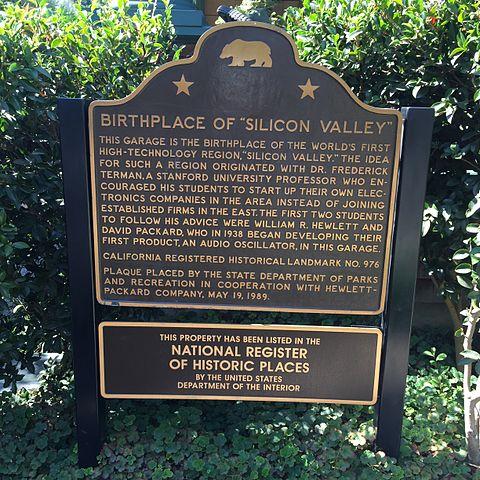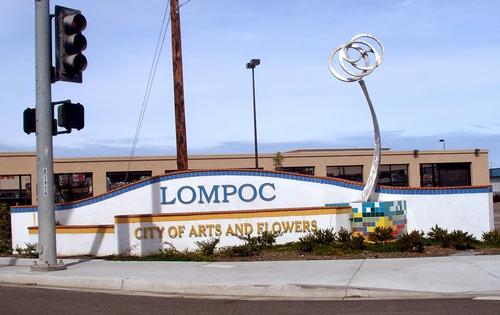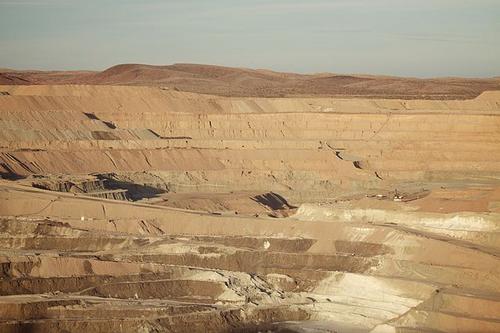CALIFORNIA
Economy

Economy

Cities in CALIFORNIA
| Los angeles | San francisco |
Popular destinations USA
| Arizona | California | Florida |
| Hawaii | Utah |
Economy
 "Birthplace" of Silicon Valley, CaliforniaPhoto: ZTebaykina CC 4.0 International no changes made
"Birthplace" of Silicon Valley, CaliforniaPhoto: ZTebaykina CC 4.0 International no changes made
If California were an independent country, its economy would be somewhere below the world's top ten in terms of national income. The enormous prosperity and associated well-being of the state have, however, been severely affected in recent years by the strong population growth and a severe economic depression.
The main branch of the economy is industry: aircraft, missiles, ships, food, iron and steel products, electronic and chemical products; also film industry (Hollywood).
The principal agricultural products are cotton, grapes, oranges, and tomatoes, with Central Valley at the heart of California's agricultural industry; the main agricultural county is Fresno County, which is where all the raisins in the United States come from. Lompoc Valley in southern Central California is one of the largest flower seed producers in the world, including asters, marigolds, cornflowers, lathyruses, lobelias, delphinium and watercress. The Oxnard area, just south of Santa Barbara, produces nearly all of the United States' broccoli crop. California is also the main supplier for the entire country when it comes to artichokes.
 Lompoc, California producer of flower seedPhoto: Coolcaesar at the English language Wikipedia CC 3.0 Unported no changes made
Lompoc, California producer of flower seedPhoto: Coolcaesar at the English language Wikipedia CC 3.0 Unported no changes made
California is by far the most important wine region in the United States with two-thirds of the national wine production, a total area of more than 210,000 hectares and with more than 60,000 registered brands. The California wine region used to be just north of San Francisco; nowadays almost the entire state can be qualified as a wine region. It could be that California is the second largest wine 'country' in the world after France, Italy and Spain.
Grapes used are Chardonnay, Sauvignon Blanc, Cabernet Sauvignon, Chenin Blanc, Pinot Blanc, Gewürztraminer, Johannesberg Riesling, Syrah and Pinot Noir. A special grape variety is the zinfandel, imported from Europe in around 1850, probably Croatia. The California wine industry, which today increasingly focuses on the sustainable production of wine, originated in the Sonoma Valley around 1824 with approximately 250 wineries; many wineries later chose the Napa Valley, currently the heart of the Northern California wine industry with more than 350 wineries. This area has the ideal conditions for the wine grapes in terms of soil, sunlight and precipitation. The largest winery in the world is E&J Gallo Winery in Modesto. In total, California has more than 3,000 wineries. San Joaquin Valley currently produces the most liters of wines, often of the cheaper kind.
In 1857 the Hungarian Count Agoston Haraszthy (1812-1869) introduced the first European grape varieties in the Sonoma Valley. Since the 1980s, the area known as Santa Barbara Wine Country has also been widely produced by more than 100 wineries. Other emerging wine regions in 'Wine Country' include Russian River Valley, Santa Barbara County, Mendocino Ridge Wine Country, Monterey Wine Country, Paso Robles, Anderson Valley, Santa Cruz Mountains, Santa Ynez Valley, El Dorado County, Temecula Valley, and Amador County.
 Count Agoston Haraszthy introduced European grape varieties to CaliforniaPhoto: Public domain
Count Agoston Haraszthy introduced European grape varieties to CaliforniaPhoto: Public domain
Livestock farming is also important, as is fishing. Eureka, the largest coastal town north of San Francisco, catches 90% of the Pacific Ocean shrimp and Dungeness crab in California. In addition, three quarters of all oysters.
California is the third largest mining state in the United States; the main products are petroleum, natural gas, cement, sand, gold, boron salts and uranium. The technology companies in Silicon Valley are booming, including Apple, IBM and Google having their headquarters here.
Of interest to tourism include Yosemite and Sequoia National Parks, Death Valley National Park, and Joshua Tree National Park.
Garberville in northern Humboldt County is the center of California's legal (medical) cannabis industry. The village even has a Humboldt Cannabis College. One-fifth of Humboldt County's population is engaged in marijuana cultivation.
In 1880 the white, crystalline mineral borax was found in Death Valley by the French prospector Isidore Daunet (1850-1884), and mining started in 1882. In 1927, the world's largest stock of borax was discovered near the town of Boron in the Mojave Desert. The largest open pit mine in California, the Rio Tinto Boron Mine, is now located there, 1.6 km wide, 4 km long and almost 2 km deep. Approx. 40% of the global demand for borax is mined in this mine. Borax is used in the production of glass, porcelain, earthenware, fertilizers, insecticides and even in space travel.
 Borax mine in Boron, CaliforniaPhoto: Marcin Wichary CCAttribution 2.0 Genericno changes made
Borax mine in Boron, CaliforniaPhoto: Marcin Wichary CCAttribution 2.0 Genericno changes made
Sources
BBC - Country Profiles
Benson, Sara / California
Lonely Planet
Benson, Sara / Discover California
Lonely Planet
Californië
Uitgeverij Cambium B.V.
CIA - World Factbook
Elmar Landeninformatie
Hansen, Preben / 100% Californië & West-USA
Mo'Media
Heetvelt, Angela / Zuidwestelijke staten van Amerika
Gottmer/Becht
Mangin, Daniel / Californië : de reisgids voor een actieve & culturele vakantie
Wat & Hoe
Ominalowska, Malgorzata / Californië
Uitgeverij Unieboek/Het Spectrum
The Rough Guide to California
Rough Guides Ltd.
Schmidt-Brümmer, Horst / Lannoo's autoboek Californië en Zuidwest-USA : on the road
Lannoo
Vlahides, John A. / Northern California
Lonely Planet
Wikipedia
Zuidwest-USA
Uitgeverij Terra Lannoo
Copyright: Team The World of Info